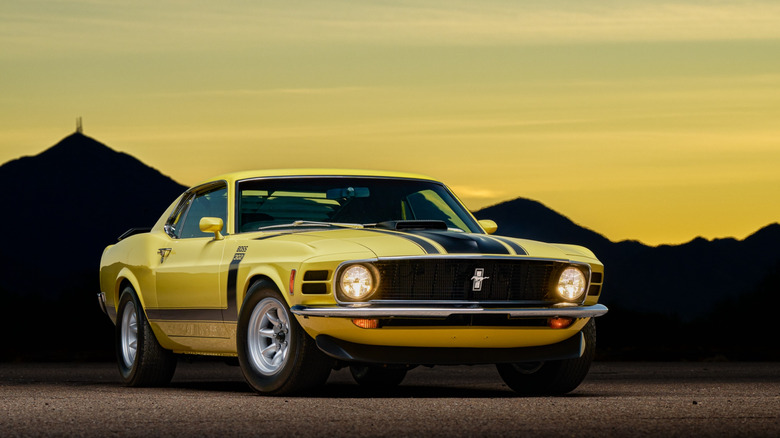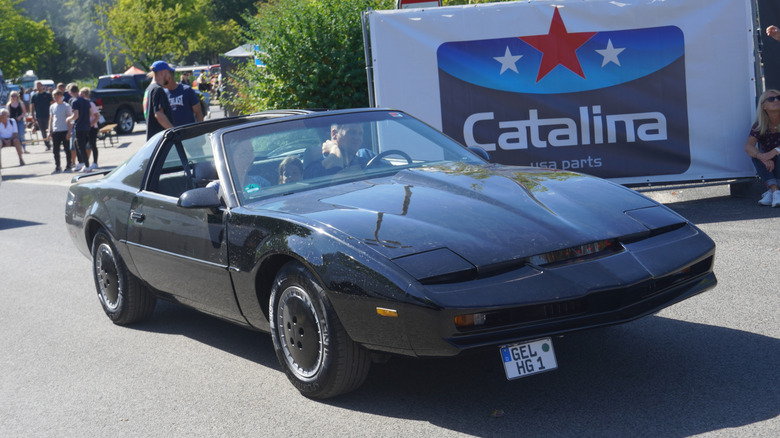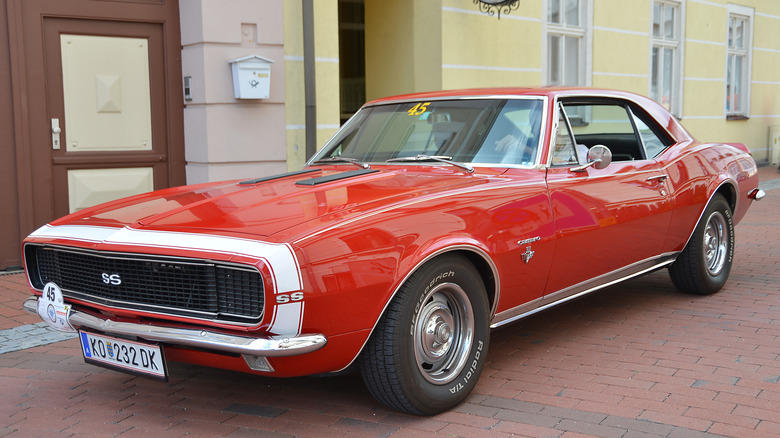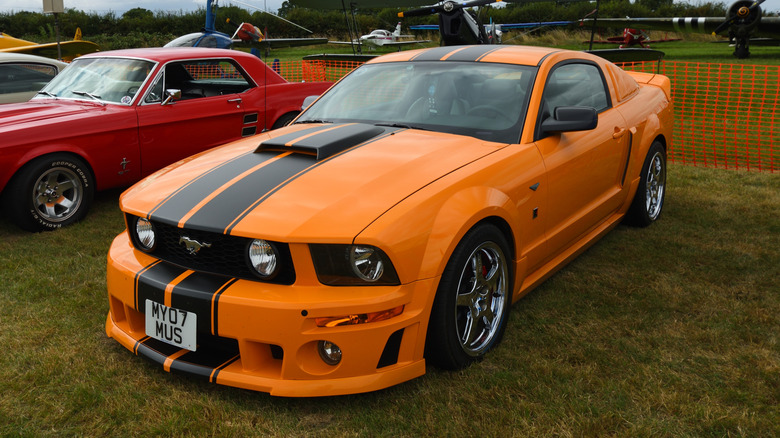8 Of The Best-Looking Muscle Cars Ever Designed
There are a multitude of reasons why you might want to take a classic muscle car for a spin, or maybe even own one. Handling and cornering capabilities definitely aren't among those reasons, but their straight line speed, engine sound, and design are completely indisputable aspects of their appeal.
However, what good is a muscle car if it doesn't look cool? Aesthetics may not have been the primary focus for the original models of the dawn of the muscle era, but the look of classic and modern muscle cars is huge part of why both enthusiasts and even some non-enthusiasts love them.
American manufacturers have knocked out some stinkers over the past few decades, like the Pinto-based Mustang II or the mid '70s Dodge Challenger, which was actually just a Mitsubishi. However, for every stinker, there was a fabulous proper muscle car to remind us why they're so awesome. Only a few can make a claim to the title of best-looking, though.
Pontiac Firebird (third generation)
The 1980s were unmistakably the era of the wedge shape. Obviously, supercars adopted this type of design and became well-known for it, but even outside of the supercar space, some cars took inspiration from the same geometry. Just get a load of the third generation of the Pontiac Firebird.
Sold for a whole decade from 1982 to 1992, the third-gen Firebird might look more familiar in a black paint scheme and a red light in the front, and a breathing sound effect here and there. Even when it's not in its KITT attire, the third-gen Firebird looks fantastic.
Everyone talks about the catfish Camaro and Firebird, but this precursor to the catfish era has its own unique charm, and it looks a fair bit European for what is still an American muscle car. In this case, Pontiac pulled it off, and it's one fabulous thing to look at. This Firebird even offered a pathetic four-cylinder engine with economy car levels of power, but obviously, that's not the one you want.
Chevrolet Camaro (first generation)
If you didn't choose the Alfa Brera or Mazda RX-8 on your first playthrough of "Need for Speed: Carbon," you chose this. The first generation Chevy Camaro came as a direct response to the arrival and stratospheric rise of the Ford Mustang. Frankly, we have to commend GM, as it put together and released the Camaro, along with its sister car, the original Pontiac Firebird within a couple of years of the first Mustang reaching Ford dealerships across the country.
The Camaro, like the Mustang, was a pony car with a basic six-cylinder with 140 hp or 155 hp in the lower end models, all the way to a super muscular 396 cubic-inch V8 in the SS, for those who wanted the performance to match the looks. Boy, those looks were rather special.
More often than not, the 1969 Camaro and its hideaway headlights gets all the love, but it's time to pay some attention to the '67 model. The pointy nose, the rear haunches, that instantly recognizable rear end with its horizontal taillights and that SS badge in the middle, the first gen Camaro is a looker through and through.
Ford Mustang Boss 302 (1969-1970)
Almost immediately after the original Mustang was launched, Ford got to work improving it and refreshing it, as well as introducing a handful of special models here and there. One of the absolute peaks of Mustang design came along in 1969 with the introduction of the original Boss 302.
After the Carroll Shelby-designed GT350 Mustang did some numbers at the SCCA championship, Ford continued the Mustang's stint at the championship with the Boss 302. This was designed and built by two former GM employees who knew exactly what made the Mustang's main competitor so good on the circuit tick. As the name implied, powering the Boss 302 was a 302 cubic inch, or 5.0-liter naturally aspirated V8 putting out 290 hp.
The Boss 302 was super successful on the circuit, and it also spawned one of the best-looking road-going Mustangs. With its standard longroof, the matte hood, the super aggressive front end and splitter, the five-spoke wheels, the graphics, the Boss 302 is one of the archetypal classic muscle cars, and that's saying a lot.
Dodge Charger (first generation)
When the Dodge Charger name is mentioned, it conjures up images of the Fast Saga or maybe "The Dukes of Hazzard." That's the second generation Charger, offered from 1968 to 1970. This has all but ensured that almost everyone has completely forgotten about the generations that came before and some that came after.
The Dodge Charger actually first appeared in 1966, and its look was vastly different compared to the Coke bottle that we all know and love. The first generation Chargers were a lot smoother and slimmer, resembling more of a personal luxury car than a proper muscle car.
While perhaps not as recognizable as the second generation Chargers, the first generation has a charm of its own, and it's high time it received some attention. If you get the idea one day to do a pro touring build on a Mopar muscle car, this is a worthy option.
Plymouth Cuda
The Mopar E-body platform gave us the 1970 Dodge Challenger, which in itself spawned the almost mythical Black Ghost. However, from this era, the E-body darling will always be the Plymouth Barracuda, otherwise known as the Hemi Cuda or just the Cuda.
Similar to the Challenger though it may be, the Cuda is one car that gets the muscle car styling formula just right. Few cars at the beginning of the '70s had so much presence and intention as the Cuda, not to mention aggression.
The Cuda is one fabulous looking muscle car, and it had some mind bogglingly powerful engines on offer to back up that look. The most notable of those is the 440, with a 440 cubic inch or 7.2-liter V8 with three dual-barrel carburetors putting out almost 400 hp, which was completely unfathomable for the time. Plymouth's flagship muscle car didn't last very long, and eventually, it had to be killed off. Sadly, the Cuda nowadays comes with one major caveat: values have absolutely skyrocketed.
Ford Mustang (S197)
In the latter half of the 20th century, the Ford Mustang had a bit of an identity crisis. It briefly became a more economy-focused car with the Mustang II, then a boxy car with no real resemblance to a muscle car with the Fox Body. Things finally began to look up with the SN-95 Mustang, as the facelift of that car finally brought back some of that muscle car aggression.
When the S197 Mustang came along, it was clear that Ford spent too much time reinventing the wheel, while the best possible design was right in front of it the whole time. While American automakers struggled with retro styling in the 2000s, the S197 Mustang was an exception.
The front foglights, the general muscle car shape, the round headlights, the upright rear deck with the three slat tail lights, the retro wheel designs — it was all there, and it was gorgeous. The S197 Mustang wasn't the best handling car of its day, and neither was the facelift, but it looked so good, it didn't really matter.
Dodge Challenger (third generation)
Not wanting to be outdone by the Mustang's return to form, Dodge revived the Challenger back in 2008, with a heavy reliance on retro styling. The new Camaro thoroughly modernized, the Mustang kept it familiar while making some changes, but the Challenger went all in.
It very closely resembled the original E-body Challenger of the early '70s, just a bit bigger and a bit more modern. Like its predecessor, the Challenger was available with massive, burly V8 powertrains and almost all of them were RWD.
This design worked so well for Dodge, they kept it for a good 15 years. In that time, the Challenger only received one major facelift, and continued to break records with the Hellcat and all of the derivatives that used the Hellcat powertrains. While the new Charger Daytona is more than likely a good car in its own right, the third generation Challenger is one American legend whose retirement we're still mourning.
Ford Torino
In the realm of Ford muscle cars, the Mustang is the one we all know and love. So much so, that Ford's other muscle cars from the same time period don't get nearly as much attention as they deserve. Technically, the Torino isn't even really a muscle car. It first appeared in the late 1960s as Ford's answer to the Chevy Chevelle; a personal luxury car that was a few levels above the Mustang.
However, despite being classed in such a way, the Torino was still available with massive V8 engines that you'd also find in a lot of other muscle cars, and of course, other Ford vehicles. Sure, the base model only had an I6, but the GT version used the beloved 302 ci V8.
Design is also on the Torino's side, as almost every generation looks spectacular. Whether its the first generation car's slimmer overall look, the 1976 Torino of "Starsky and Hutch" fame, or the 1972 model we saw in "Fast and Furious" (the fourth film in the series), it's a brilliant piece of design.








